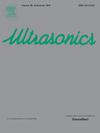Specific Filtered Delay Multiply and Sum beamforming for coherent multi-transducer ultrasound imaging
IF 4.1
2区 物理与天体物理
Q1 ACOUSTICS
引用次数: 0
Abstract
Coherent multi-transducer ultrasound (CoMTUS) imaging enables the use of multiple arrays as one large effective aperture yielding images with enlarged field-of-view, improved resolution, and higher signal-to-noise ratio. However, creating a large but discontinuous effective aperture increases the grating and sidelobe levels, and generates cross-talk artifacts between arrays. These additional challenges can degrade the contrast of the images obtained through the classic Delay and Sum (DAS) beamforming algorithm.
This study investigates the possibility to improve contrast and reduce artifacts in CoMTUS by using an alternative nonlinear beamforming algorithm, the Filtered Delay Multiply and Sum (F-DMAS). We implemented a specific F-DMAS beamforming algorithm for CoMTUS considering the resulting effective aperture and tested its performance in a coherent dual-array system for 2-D imaging. The comparison between CoMTUS images obtained through F-DMAS and DAS was investigated by both simulations and experiments, including in vivo results. For a typical dual-probe configuration, CoMTUS specific F-DMAS was shown to be effective at lowering the sidelobes and the noise floor, resulting in better quality B-mode images with improved sidelobe suppression (first sidelobe amplitude decreased from -13.0 dB to -24.7 dB; side-lobe-to-main-lobe energy ratio decreased from 9.3 dB to 1.9 dB).
相干多换能器超声成像的特定滤波延迟乘和波束形成
相干多换能器超声(CoMTUS)成像可以使用多个阵列作为一个大有效孔径,产生具有扩大视场,提高分辨率和更高信噪比的图像。然而,创建一个大而不连续的有效孔径增加了光栅和副瓣电平,并产生阵列之间的串扰伪影。这些额外的挑战会降低通过经典的延迟和(DAS)波束形成算法获得的图像的对比度。本研究探讨了通过使用一种替代的非线性波束形成算法,滤波延迟乘和(F-DMAS)来提高对比度和减少CoMTUS中伪影的可能性。考虑到产生的有效孔径,我们为CoMTUS实现了一种特定的F-DMAS波束形成算法,并在相干双阵列系统中测试了其用于二维成像的性能。通过模拟和实验对F-DMAS和DAS获得的CoMTUS图像进行了比较,包括体内结果。对于典型的双探头配置,CoMTUS特定的F-DMAS被证明可以有效地降低副瓣和本底噪声,从而获得质量更好的b模式图像,并改善副瓣抑制(第一副瓣幅度从-13.0 dB降低到-24.7 dB;旁瓣与主瓣能量比从9.3 dB降至1.9 dB)。
本文章由计算机程序翻译,如有差异,请以英文原文为准。
求助全文
约1分钟内获得全文
求助全文
来源期刊

Ultrasonics
医学-核医学
CiteScore
7.60
自引率
19.00%
发文量
186
审稿时长
3.9 months
期刊介绍:
Ultrasonics is the only internationally established journal which covers the entire field of ultrasound research and technology and all its many applications. Ultrasonics contains a variety of sections to keep readers fully informed and up-to-date on the whole spectrum of research and development throughout the world. Ultrasonics publishes papers of exceptional quality and of relevance to both academia and industry. Manuscripts in which ultrasonics is a central issue and not simply an incidental tool or minor issue, are welcomed.
As well as top quality original research papers and review articles by world renowned experts, Ultrasonics also regularly features short communications, a calendar of forthcoming events and special issues dedicated to topical subjects.
 求助内容:
求助内容: 应助结果提醒方式:
应助结果提醒方式:


